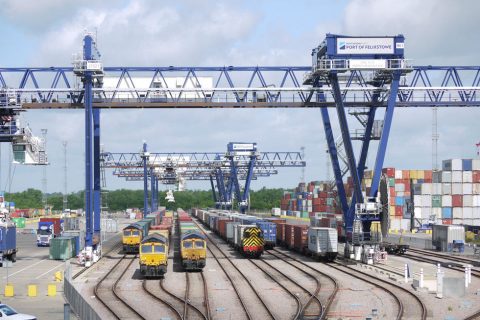
UK container freight to EU increased
Container traffic between UK ports and EU countries increased by nine per cent to 3.6 million TEUs in 2016. In units, the increase was eight per cent to 2.0 million units. Freight traffic to and from the EU grew significantly more than traffic between the UK and other parts of the world. These statistics were revealed by the UK’s Department for Transport last week.
Looking at the total volume of traffic passing through UK ports last year, an increase of three per cent to 10.2 million TEUs was observed in container volume, while the increase accounted for two per cent to 24.1 million in units. Maritime freight transport to and from the EU accounted for 44 per cent of all tonnage passing through UK major ports.
UK-EU container transport
The Netherlands still receives the majority of all container traffic headed to the EU. A total of 1.2 million TEUs was exported from the UK to the Netherlands, indicating a 32 per cent share. However, UK container export to the Netherlands accounted for 39 per cent of all EU export a year earlier. In contrast, UK container export to Germany grew significantly with 31 per cent to 0.5 million TEUs in 2016. In total, container export to the EU rose by 11 per cent to 2.1 million TEUs.
For the import from the EU, the Department of Transport revealed the volumes in total tonnage, instead of container volume. Imports made up 56 per cent of all tonnage handled between the UK and EU countries. UK major ports received 116.6 million tonnes from countries in the EU in 2016, an increase of 4 per cent compared to 2015. Also here, the Netherlands represents the largest share, more than a quarter of all inward tonnage from the EU. In 2016, 31.5 million tonnes of freight was imported from the Netherlands.
Decline in coal demand
Although container volumes handled by UK ports have seen a steady increase over the years, a different trend becomes evident when looking at the total tonnage passing these ports. Overall freight tonnage handled by UK ports declined by three per cent in 2016. This is due to a large reduction in demand for coal imports, explained the Department for Transport.
Important export countries of liquid bulk imports are Germany and France. Hence, when looking at export volumes in tonnes, a decrease of 11 per cent was witnessed for both countries. Interestingly, exports to Italy nearly doubled to 1.8 million tonnes, with an increase in crude oil imports from 0.4 million tonnes in 2015 to 1.3 million tonnes in 2016. Similarly, export of crude oil to China and America witnessed a significant increase last year.
Here you can read the full report of the Department for Transport.





